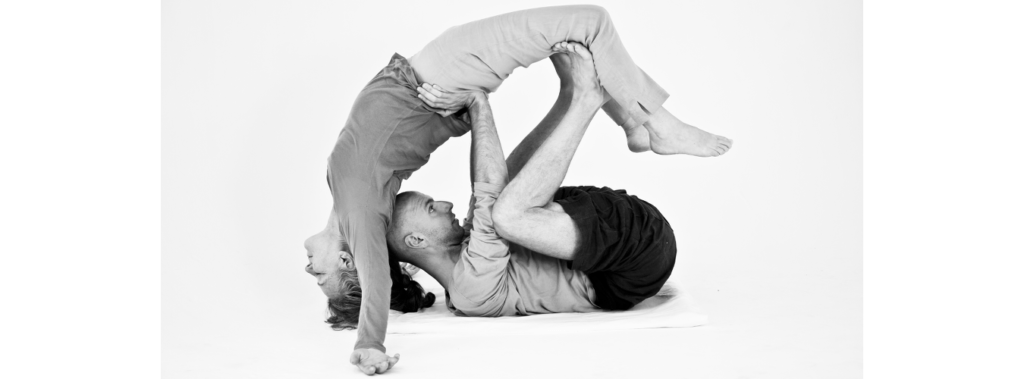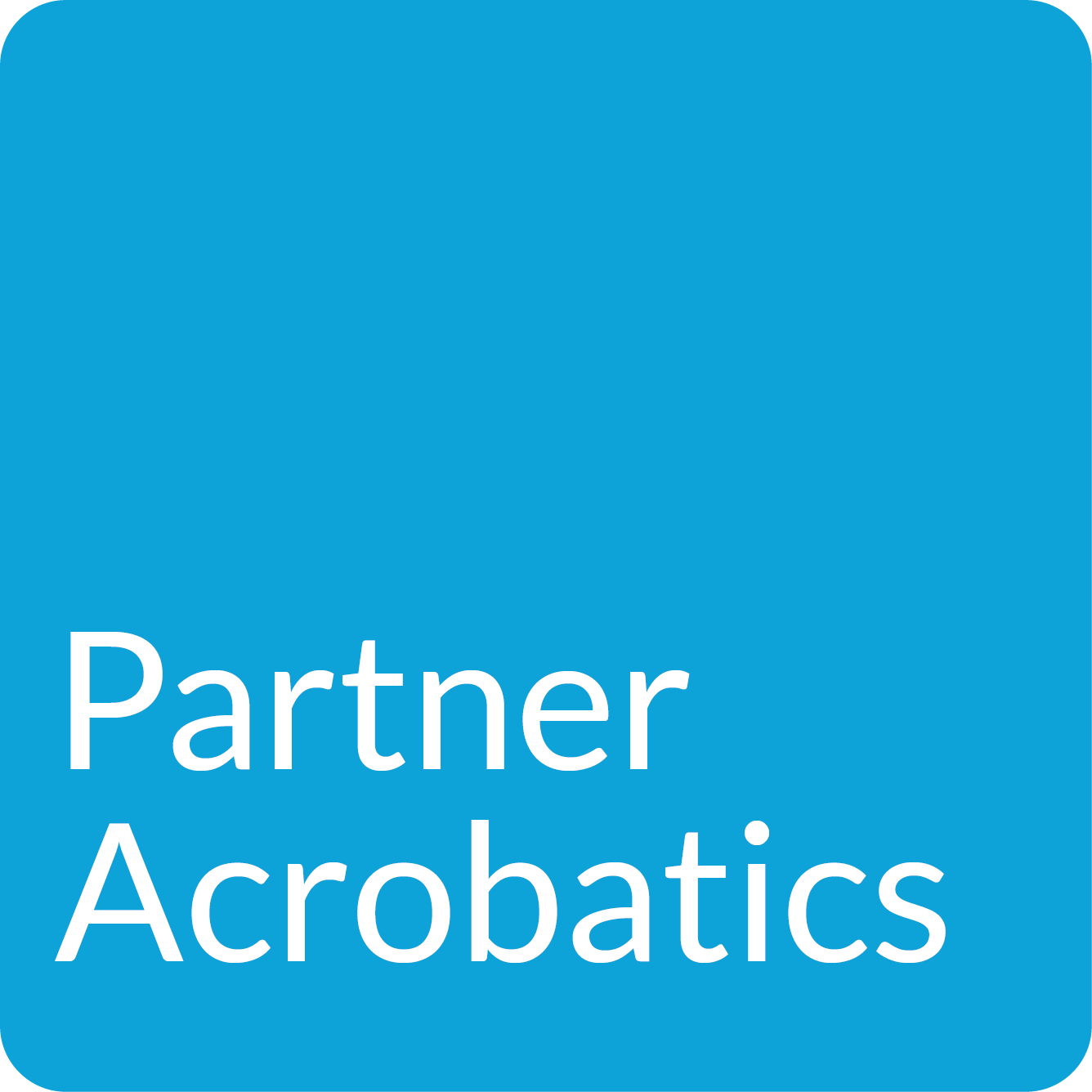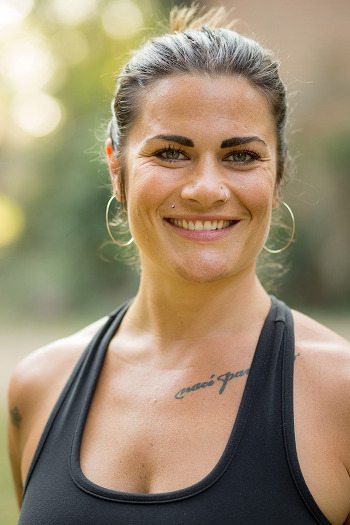
Flying Therapeutics. How do I love thee? Let me count the ways…
The childlike joy of going upside down. The sensation of the pull of gravity in a new way. The relaxation while I let someone support me. These are some of the ways in which I love thee.
I truly love the way I can momentarily disconnect on some level from the pull of gravity.
When my eyes are closed and I’m being supported by a skilled practitioner, space seemingly fades away. It is almost as if I am floating free, suspended in time. My heart rate lowers, my breath evans and slows, my mind stills. In this state, as with other styles of bodywork, it is natural for emotions to be released, anything from giggles to tears.
Is it for everyone? Not necessarily. It can be a very challenging form of body work to learn to receive. In order to receive the major benefits of this modality, one needs to be able to release and trust their practitioner. This alone can present issues. A portion of the massage is also given while the receiver is in an inverted position so people with glaucoma, epilepsy, neck injuries, disc problems, high blood pressure, and issues related to blood pressure changes might be at risk. It is very important to consult your doctor before deciding to seek out Flying Therapeutics.
What exactly is an inversion? Essentially, an inversion, as it relates to yoga and for the purposes of this article, Flying Therapeutics, is any position that puts the feet and hips above the heart and the head. While many practitioners of FT will begin and end the experience on a mat, the recipient will be lifted away from the floor for a portion of the massage and supported in some variation of an inversion.
You might ask yourself why would you choose this form of therapy. Well, based on yogic philosophy and more recent clinical research being done, going upside down has a number of amazing benefits such as supporting improved immunity, promoting better sleep, aiding in digestion, alleviating sciatic pain, improving circulation,and diminishing depression to name a few.
Do you remember hanging upside down at the playground when you were a kid? Maybe not. But if you do, it probably put a smile on your face at just the memory of it. Chances are you didn’t know why, you probably didn’t even care why it made you feel good. It just did. Well studies are beginning to show that “being upside-down directs blood flow to your head and brain. Increased blood flow means increased oxygen delivery to your cells. This means increased bioavailability of oxygen and glucose — both of which are needed for optimal brain function, memory and clear thinking.” 1
In addition to thinking clearly it is suggested that going upside down may stimulate our bodies to produce endorphins, serotonin, and dopamine; three of the so called “happy” hormones produced in our bodies. While diet and exercise are proven to stimulate the endocrine system into producing these hormones, it is also suggested that “With the assistance of the change in gravity, inversions cause venous blood from the lower extremities to drain towards the heart. The increased blood perfusion may stimulate a healthier exchange of nutrients and the flushing of wastes from endocrine glands. Thus this may promote endocrine gland function and hormone secretion, as well as the circulation of hormones in the vascular system to other sites in the body”. 2
A study done by UCLA published in the Journal of Alternative Therapies in Health and Medicine concluded that inversions positively affect the states of depression and anxiety, decrease fatigue levels, as well as stimulate higher levels of the hormone cortisol in the morning (Woolery et al, 2004). 3
As going upside down stimulates and provides fresh blood flow to not just one or two of the glands of the endocrine system, it is arguably beneficial to the pituitary and hypothalamus glands as well. These glands are often referred to as “The Master Glands” since they regulate all other glands in the body (thyroid, pineal, and adrenals). This includes our sexual hormones, so you can expect better sex with a consistent headstand practice. (And who doesn’t want that?)
In addition to making us feel good emotionally, it is also possible that the activity of inverting can help one to feel better physically. Here are a few examples of how and where you might feel improvement.
- Because the heart constantly has to pump blood upward to the brain, an inversion gives the heart a rest and reduces unnecessary strain, thereby improving circulation. In addition, while upside down, de-oxygenated blood is able to flow more easily from the extremities to the heart.
- Edema (excess fluid trapped in the tissues) in the lower extremities can be alleviated by inverting, thereby decreasing one’s risk of developing varicose veins.
- When one inverts, the movement of waste through the ascending colon is assisted by the reversal of the pull of gravity. In this way congested blood in the colon can be released.
- The lymph system, which helps to eliminate the waste products from your blood, receives stimulation though the reversal of gravity and so toxins are removed with more efficiency from your body.
What about back pain?
Due to the mostly sedentary lifestyles that has become the norm for so many people in this day, back pain is an increasing issue. For years, it seems, inversion tables have been on the so-called “scene” and at the center of some debates over their effectiveness. And while there is still relatively little proof to back up some of the claims, there is starting to be more attention in the scientific field about their usage.
Sunshine Press cites a clinical research study conducted at Newcastle University in England from February 2003 to September 2006, that supports this point. In this study, twenty-two patients suffering from sciatic nerve pain due to a disc protrusion were studied. In all cases, their physician had recommended back surgery but they were all hoping to avoid it by undergoing physical therapy.These patients were split into two groups, one receiving physical therapy alone, and the other receiving both physical therapy and inversion therapy on an inversion table.
The results of the Newcastle University showed an overwhelming advantage for the group that did the inversion therapy. Here is a summary of those results:
1. 78 percent of those patients who received physical therapy only still had to have back surgery.
2. On the other hand, only 23 percent of those patients who did the inversion therapy still had to have back surgery. This means that inversion therapy saved 77 percent of that group from having to undergo painful, and all too often ineffective, back surgery!
It needs to be acknowledged that going upside down isn’t necessarily as easy as it sounds. It can take lots of practice and often strength to become comfortable in any of the yogic inversions and many of us may not be willing to just jump on board and run out and buy an inversion table. That is where your Flying Therapeutics practitioner comes in. Let a proficient and confident therapist help you on this journey. In addition to receiving the benefits of inversion, you gain the support of a human connection.
So if inversions are so beneficial and can help reduce pain and even “cure” certain ailments then why aren’t there more studies showing this? It needs to be taken into account how many studies are funded. Quite often the pharmaceutical and medical device companies fund research to tout the effectiveness of their products and the alternative treatments don’t get the same attention. However, while there is little scientific evidence, as of yet, to the quantifiable benefits of inverting, there are plenty of people who absolutely believe in the power of going upside down and there are plenty of professionals who use these techniques and get great results.
This is not to say that Flying Therapeutics is or can be a “cure all”. The question becomes, how does it make you feel? I for one, have a daily inversion practice. I love the way it makes me feel and it is a real treat when I have someone help me.
Add all of this to the Flying Therapeutics session and you receive a compounded experience.
1. http://www.mindbodygreen.com/0-17396/what-yoga-inversions-sex-have-in-common.html Claudia Richey
2. http://etherealbody.com/Endocrine_System_and_Inversions.html Krista Augius, Doctor of Physiotherapy, Yoga Instructor
3. Woolery, Allison et al. A Yoga Intervention for Young Adults with Elevated Symptoms of Depression. Alternative Therapies in Health and Medicine; Mar/Apr 2004; 10,2; Health Module pg. 60
4. http://sunflower-press.com/benefits-inversion-table-therapy/#stress Jim Corkern

